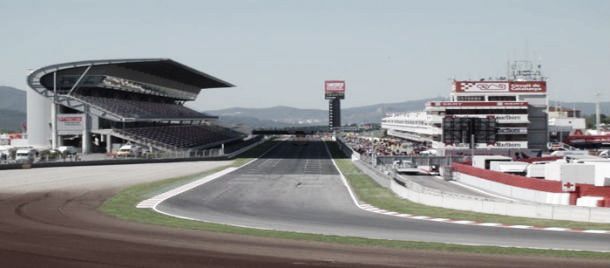As Formula One makes its way to Barcelona for the second test of pre-season, here’s a look at the Circuit de Barcelona Catalunya.
It first hosted the Spanish Grand Prix in 1991, taking the place of Jerez, ironically the location of the first test. Since 1991 the Spanish Grand Prix has been a favourite for fans and drivers alike. With a capacity of 140,700, many fans flock to attend the race, mainly due to Spaniard Fernando Alonso.
Michael Schumacher is the most successful driver around the circuit, with six wins, including a memorable win in 1996 when he won his first race for Ferrari in torrential conditions. Ferrari also hold the lap record, with Kimi Raikkonen setting a lap of 1:21:670 in 2008, which hasn’t been beaten yet.
In the Mortmeló region, this track begins with a long run to the first corner. With a DRS zone along the finish straight, many overtakes are made here, with it being particularly exciting to see who brakes latest into the first corner. Turn one, Elf, is a sharp right hander, which can catch many out, but it leads into a sweeping left hander, taken at around third gear.
Turn three is a long right hand corner which exposes the drivers to ridiculous amounts of g-force, some reach 4G round the corner, known as Renault. The Repsol curve follows, and isn’t too dissimilar to the Parabolica, found at Monza. Another right hander, it’s all about finding the right apex into this corner, before putting the foot down on the exit.
Moving slightly downhill the drivers need to slow right down for the second gear Seat corner, a tight left hander taken in second gear which leads into an uphill kink before the part of the track which can be problematic. Turns seven and eight is a right left chicane leading uphill, the problem is the kerb on turn eight’s inside. It can cause serious suspension damage if driven over, and takes no prisoners.
Campsa corner is a blind crest which can catch many drivers out, as it’s not possible to see the rest of the corner in a Formula One car. This leads on to the long back straight, another place for DRS. Turn ten, La Caixa, is a very tight first gear corner, which can cause many incidents with drivers hurtling towards the corner at speeds exceeding 200mph.
Once negotiated, the drivers rise uphill into another chicane, leading into a third gear right hander, overtakes are attempted here but rarely pulled off due to the narrow exit, which leads into turn 13, a tight right hander in a complex introduced to the circuit in 2007 in an attempt to improve overtaking.
Created by famous modern circuit designer Hermann Tilke, the collection of corners hasn’t had the desired effect, as overtaking is much more difficult due to the tight nature of turns 14 and 15. These are a left right chicane which is very harsh on suspension due to the big kerbs. In the rain this is a prime location for spinning drivers. The final corner, New Holland is a sweeping right hander which leads onto the finish straight.
New Holland used to be a place where drivers would gather slipthrough the corner before making their move down the straight, however with the introduction of turns 14 and 15, coupled with DRS have made this corner a shadow of its former self.
The 2014 race was won by Mercedes’ Lewis Hamilton, who converted pole position into victory. The podium was completed by team mate Nico Rosberg and ever smiling Red Bull driver Daniel Ricciardo. Memorable moments of this circuit include Nigel Mansell and Ayrton Senna's battle into turn one in 1991, Schumacher's 1996 win and 2012 seeing the first F1 win for a Venezuelan, Williams' Pastor Maldonado.









































